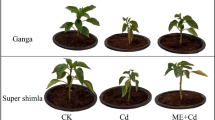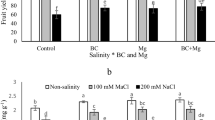Abstract
Influence of ladder concentration of nickel (Ni) on the leaves of Hydrocharis dubia were studied after 3 days treatment. The accumulation of Ni, the content of polyamines, proline, malondialdehyde (MDA) and soluble protein, as well as the activities of superoxide dismutase (SOD), catalase (CAT) and peroxidase (POD) in the leaves were investigated. The result indicated that the toxicity of Ni manifested in respective aspect of physiological and biochemical characters. Significant increase of Ni concentration in the leaf tissue was observed, which was concentration dependent. Visible symptoms of Ni toxicity: chlorosis and necrosis occurred following the 3rd day. Meantime, treatment with Ni resulted in the increase in the generation rate of O •−2 in the leaves. SOD and CAT activities decreased significantly in response to Ni treatment, it was possibly the reason of accumulation of O •−2 . However, a several-fold decrease in POD activities was found. Our results indicated that because of prolonged increases in O •−2 level, oxidative damage, measured as the level of lipid peroxidation, occured in the leaves of Ni treated fronds. The changes of the content of polyamines (PAs) were also investigated in the leaves of Hydrocharis dubia. Ni treatment significantly increased the putrescine (Put) level and lowered spermidine (Spd) and spermine (Spm) levels, thereby significantly reducing the ratio of free (Spd + Spm)/Put in leaves, which has been considered as the signal under stress. Although the trend that PS-conjugated PAs and PIS-bound PAs changed the same as free PAs, they changed in more less extent.





Similar content being viewed by others
References
Abbasi AS, Ramasami E (1999) Biotechnological methods of pollution control. Universities Press, Hyderabad, p 168
Alloway BJ (1990) Heavy metals in soils. Blackie, New Jersey
Atal N, Saradhi PP, Mohanty P (1991) Inhibition of the chloroplast photochemical reactions by treatment of wheat seedlings with low concentration of cadmium: analysis of electron transport activities and changes in fluorescence yield. Plant Cell Physiol 32:943–951
Aziz A, Larher F (1995) Changes in polyamine titers associated with the proline response and osmotic adjustment of rape leaf discs submitted to osmotic stress. Plant Sci 112:175–186
Baccouch S, Chaoui A, El Ferjani E (2001) J Plant Nutr 24:1085–1097
Bar Y, Apelbaun A, Kafkafi U, Goren R (1996) Polyamines in chloride stressed Citrus plants: alleviation of stress by nitrate supplementation via irrigation water. Amer Soc Hort Sci 121:507–513
Bates LS, Waldren RP, Teare ID (1973) Rapid determination of free proline for water-stress studies. Plant Soil 39:205–207
Benavides MP, Aizencang G, Tomaro ML (1997) Polyamines in Helianthus annuus L. during germination under salt stress. J Plant Growth Regul 16:205–211
Besford RT, Richardson CM, Campos JL, Tiburcio AF (1993) Effect of polyamines on stabilization of molecular complexes in thylakoid membranes of osmotically stressed oat leaves. Planta 189:201–206
Bouchereau A, Aziz A, Larher F et al (1999) Polyamines and environmental challenges: recent development. Plant Sci 140:103–125
Bradford MM (1976) A rapid and sensitive method for the quantitation of microgram quantities of protein utilizing the principle of protein-dye binding. Anal Biochem 72:248–254
Cohen SS (1998) A guide to the polyamines. Oxford University Press, New York
Davies KJA (1987) Protein damage and degradation by oxygen radicals: 1. general aspects. J Biol Chem 262:9895–9901
Drolet G, Dumbroff EB, Legge RL et al (1986) Radical scavenging properties of polyamines. Phyto Chem 25:367–271
Eskew DL, Welch RM, Cary EE (1983) Nickel: an essential micronutrient for legumes and possibly all higher plants. Science 222(11):621–623
Evans PT, Malberg ML (1989) Do polyamines have roles in plant development? Annu Rev Plant Physiol Plant Mol Biol 40:235–269
Galston AW (1997) Plant polyamines in reproductive activity and response to abiotic stress. Bot Acta 110:197–204
Gaspar T, Penel C, Hagege D, Greppin H (1991) Peroxidases in plant growth, differentiation, and development processes. In: Łobarzewski J, Greppin H, Penel C, Gaspar T (eds) Biochemical, molecular and physiological aspects of plant peroxidases. University M. Curie-Skłodowska, Lublin, Poland, pp 249–280
Ghaderian SM, Mohtadi A, Rahiminejad MR, Baker AJM (2006) Nickel and other metal uptake and accumulation by species of Alyssum (Brassicaceae) from the ultramafics of Iran. Environ Pollut 1–6
Giannopolitis CN, Ries SK (1977) Superoxide dismutase in higher plants. Plant Physiol 59:309–314
Giustino T, Claire K, Odile FR et al (2004) Effect of NaCl and mannitol iso-osmotic stresses on proline and free polyamine levels in embryogenic Fraxinus angustifolia callus. Plant Physiol 161:701–708
Gonnelli C, Galardi F, Gabbrielli R (2001) Nickel and copper tolerance and toxicity in three Tuscan populations of Silene paradoxa. Physiol Plant 113:507–514
Greger M (1999) Metal availability and bioconcentration in plants. In: Prasad MNV, Hagemeyer J (eds) Heavy metal stress in plants-from molecules to ecosystems. Springer, Berlin, pp 1–27
Gu W, Shi GX, Zhang CY et al (2002) Toxic effects of Hg2+, Cd2+ and Cu2+ on photosynthetic system and protective enzyme system of Potamogeton crispus. J Plant Physiol Mol Biol (In Chinese) 28(1):69–74
Gyth L (1991) A simple method for determination of serum catalase and revision of reference range. Clin Chim Acta 196:143–152
Hodges DM, DeLong JM, Forney CF, Prange RK (1999) Improving the thiobarbituric acid-reactive substances assay for estimating lipid peroxidation in plant tissues containing anthocyanin and other interfering compounds. Planta 207:604–611
Jänne J, Alhonen L, Pietilä M et al (2004) Genetic approaches to the cellular functions of polyamines in mammals. Eur J Biochem 271:877–894
Kadlec R, Knight RL, Vymazal J, Brix H, Cooper P, Habert R (2000) Constructed wetlands for pollution control, control processes, performance. design and operation, IWA Publishing, London, p 164
Kumar A, Altabella T, Taylor M, Tiburcio AF (1997) Recent advances in polyamine research. Trends Plant Sci 2:124–130
Larher F, Aziz A, Deleu C, Lemesle P, Ghaffar A, Bouchard F, Plasman M (1998) Suppression of the osmoinduced proline response of rapeseed leaf discs by polyamines. Physiol Plant 102:139–147
Liu XM, Wang JF, Yu RQ, Liang SZ (1999) Study on the changes of chlorophyll content and biomass of heterotrophic Chlorella vulgaris under different nitrogen concentrations. Plant Physiol 35:198–201
Lou LQ, Shen ZG, Li XD (2004) The copper tolerance mechanisms of Elsholtzia haichowensis, a plant from copper-enriched soils. Environ Exper Bot 51:111–120
Maehly AC (1955) Plant peroxidase. Methods Enzym 2:801–813
Malmberg RL, Watson MB, Galloway GL et al (1998) Molecular genetic analyses of plant polyamines. Crit Rev Plant Sci 17:199–224
Mithufer A, Schulze B, Boland W (2004) Biotic and heavy metal stress response in plants: evidence for common signals. FEBS Lett 566:1–5
Panicot M, Masgrau C, Borrell A, Cordeiro A, Tiburcio AF, Altabella T (2002) Effects of putrescine accumulation in tobacco transgenic plants with different expression levels of oat arginine decarboxylase. Physiol Plant 114:281–287
Santa Cruz A, Acosta M, Rus A, Bolarin MC (1999) Short-term salt tolerance mechanisms in differentially salt tolerant tomato species. Plant Physiol 37:65–71
Serafini DF, Del DucaS, Monti F et al (2002) Transglutaminase activity during senescence and programmed cell death in the corolla of tobacco (Nicotiana tabacum) flowers. Cell Death Differ 9:309–321
Sharma SS, Dietz KJ (2006) The significance of amino acids and amino acid-derived molecules in plant responses and adaptations to heavy metal stress. J Exp Bot 57:711–726
Shi GX, Xu QS, Xie KB et al (2003) Physiology and ultrastructure of Azolla imbricate as affected by Hg2+ and Cd2+ toxicity. Acta Botanica Sin 45(4):437–444
Smith TA (1985) The di- and polyamine oxidases of higher plants. Biochem Trans 13:319–322
Suman B, James R (1997) Puteascine aminopropyltransferase is responsible for biosynthesis of spermidine, spermine and multiple uncommon polyamines in osmotic stress-tolerant alfalfa. Plant Physiol 114:445–454
Takao K, Rickhag M, Hegardt C, Oredsson S, Persson L (2006) Induction of apoptotic cell death by putrescine. Int J Biochem Cell Biol 38:621–628
Tiburcio AF, Kaur Sawhney R, Galston AW (1990) Polyamine metabolism. In: Lea BJ (ed) Stress response in plants: adaptation and acclimation mechanism. Wiess-Liss, New York, pp 283–325
Wallace HM, Fraser AV, Hughes A (2003) A perspective of polyamine metabolism. Biochem J 376:1–14
Wang AG, Luo GH (1990) Quantitative relation between the reaction of hydroxylamine and superoxide anion radicals in plants. Plant Physiol 6:55–57
Wang X, Shi GX, Xu QS, Hu JZ (2007) Exogenous polyamines enhance copper tolerance of Nymphoides peltatum. J Plant Physiol 164:1062–1070
Acknowledgements
This research was supported by the National Natural Science Foundation of China (No. 30370083) and (No. 211100B372) Key Program of Science and Technology of Education Ministry of China (No. 01043).
Author information
Authors and Affiliations
Corresponding author
Rights and permissions
About this article
Cite this article
Zhao, J., Shi, G. & Yuan, Q. Polyamines content and physiological and biochemical responses to ladder concentration of nickel stress in Hydrocharis dubia (Bl.) Backer leaves. Biometals 21, 665–674 (2008). https://doi.org/10.1007/s10534-008-9151-x
Received:
Accepted:
Published:
Issue Date:
DOI: https://doi.org/10.1007/s10534-008-9151-x




